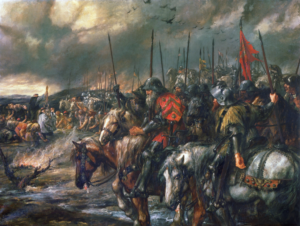
The early fifteenth century would see a mix of weapons and armour and mail depending upon who was wearing it. Let’s start with the archers (the battle winners, no matter what anyone says!)
Archers
The archers would be a mix of hired on Yeomanry who would supply their own kit and archers who were on a Lord’s payroll and who would have some equipment supplied. The archers helmet was usually of two basic types (if they had one, the poorer ones may only have had waxed leather/cloth hoods) Anyway, the helmets – the “Kettle hat” as it is called is shaped just like a first world war British/American soldiers, it is almost identical with a bowl for the head and a rim all the way around. Check out the first world war soldiers for a look. The second helmet is still basic, shaped to the head and covers it and the neck to the collar, the front is plain leaving the eyes, cheeks and mouth open and fits down the side of the face, there is no nasal bar, there would be cut outs for the ears enabling the archer to hear well.
The Captains or leader of an archer band may have a mail shirt and possibly some shoulder plates and elbow plates but not much more than this. Some archers would just have a padded jacket (gambeson?) this would be stuffed/padded with wool or fabric shreds and stitched in long seams down the garment. This stitching bunches the wool/fabric and helps to deflect or at least slow down incoming arrows or crossbow bolts, it would also deflect bladed weapons to some degree. Archers would start off the campaign with boots or at least shoes, by Agincourt many would be barefoot and even fighting trouserless! (owing to the dysentry that was rife in the army) All would carry a dagger, a “poniard” or a “ballock dagger” and/or a knife, many had small hand axes used as both a tool and weapon. Don’t forget the large wooden mallets the archers would have for driving in their wooden stakes (their anti horse device) this could also double as a weapon to bludgeon a Knight to death. The Captains may carry a short sword (badge of rank).

Men at Arms (Under a Lord)
These men are usually in a Lord’s retinue and liveried via a gambeson or shirt over their mail shirt to show their association. Not many of these would have plate armour, however some would have picked up pieces from previous battles and again the Captains would be better armed/protected than the ordinary soldier. So, usually dressed in a mail coat with a fabric or leather shirt etc over it to show their Lord’s colours. All would have a helmet but usually a basic one covering the head and neck but open faced, under this would be a mail coif that covered the back of the neck and top of the shoulders as well. Again, the veterans would likely have plate on the shoulder, elbows and knees too that they had taken from the dead in previous battles. Weapons would be axes, war hammers, halberds (pole arm with an axe one side and a spike on the other) or variations of this – axe/spike/hook etc. The hook is used to haul a Knight from his horse. Maces would be another common weapon. Short swords would be used and carried by most men at arms, all would carry a “poniard” or a “ballock dagger” both had long slim blades for slipping through helmet visors to kill quickly. All would have boots.
Knights/Lords/King
These lads are mainly in complete plate armour made to fit them personally like a modern day ‘made to measure suit’. Helmets would be visored, however I have read that many would lift their visor to enable better vision during battle (it must have been terrifying and claustrophobic in a battle when trying to look through slits? Your hearing would also be reduced) Hence archers being trained to hit a turnip at 200 yards! (see the similarities?) and thus Henry suffering an arrow wound in the face. Popular helmets were ‘Pig faced bascinets’ where the front of the helmet is shaped like a long snout with only two narrow slits for the eyes and small perforations in the snout to help breathe. They would have plate armour that was well articulated for all movement. Weapons would be maces, battle axes, shortened lances, war hammers and some would carry a shield if the weapon they were using was one handed (mace/hammer etc), if they had shortened lances they would need two hands and abandon the shield. They would have plate shoes and plate gauntlets. All would carry a sword as a badge of rank, again a dagger would be compulsory.
In this age when a Knight was so well protected the best and quickest way to kill him was; arrows to the face/bludgeoning to death/stabbing through the visor or under the armpit or groin which was hard to protect.
Archers would aim for horses as a larger target and had special shaped arrows designed to cut arteries or bury deep in unprotected areas. Once a knight was unhorsed he would likely be concussed at the least, and an easier target to beat/bludgeon/stab to death. From what I have read of Agincourt after each French charge the archers would slip out to recover arrows and dispatch wounded and concussed knights via axes/daggers/mallets etc.
******
Garrett Pearson is an author of historical fiction: 4 Books about Hannibal and one on Stamford Bridge.
Visit Garrett on Twitter: https://twitter.com/Garrett13853937